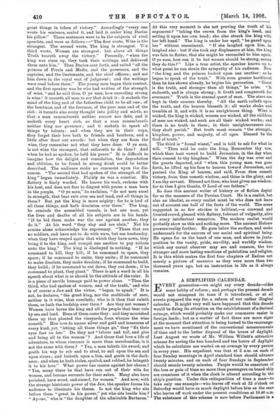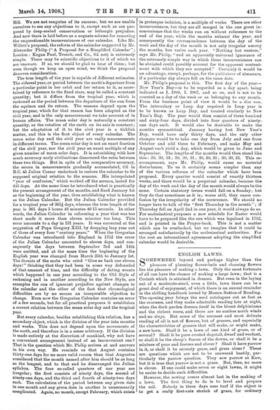A SIMPLIFIED CALENDAR.
EVERY generation—we might say every decade—rides some hobby of reform ; and perhaps the present decade would not misspend its time if it introduced, or at all events prepared the way for, a reform of our rather illogical calendar. It might very well have happened that this decade would be fixing its attention on the establishment of a decimal coinage, which would probably make our commerce easier in foreign lands; but as a matter of fact there are more signs at the moment that attention is being turned to the rearrange- ment we have mentioned of the conventional measurements of time and to the better disposal of the hours of daylight. Last August we wrote of Mr. William Willett's attractive scheme for saving the two hundred and ten hours of daylight which he calculates are wasted on an average by every person in every year. His expedient was that at 2 a.m. on each of four Sunday mornings in April standard time should advance twenty minutes, and on each of four Sundays in September should recede twenty minutes. People would be conscious of the loss or gain of time no more than passengers on board ship are conscious of it when the clock is altered according to the ship's position. Under this redisposition of time a man—to take only one example—who leaves off work at 12 o'clock on Saturday would have as much daylight before him as the man who leaves off work under the present conditions at 10.40 a.m. The substance of this scheme is now before Parliament in a
Bill. We are not sanguine of its success ; but we are unable ourselves to see any objections to it, except such as are pro- posed by deep-seated conservatism or lethargic prejudice. And now there is laid before us a cognate scheme for removing the unquestionable inconveniences of our calendar. Like Mr. Willett's proposal, the reform of the calendar suggested by Mr. Alexander Philip ("A Proposal for a Simplified Calendar"; London : Kegan Paul, Trench, and Co., 6d. net) is extremely simple. There may be scientific objections to it of which we are unaware. If so, we should be glad to hear of them ; but even though we keep an open mind, we think the proposal deserves consideration.
The true length of the year is capable of different estimates. The sidereal year, or period between the earth's departure from a particular point in her orbit and her return to it, as ascer- tained by reference to the fixed stars, may be called a constant quantity; but it differs from the tropical year, which is reckoned as the period between the departure of the sun from the equinox and its return. The seasons depend upon the tropical year, which for that reason has been adopted as the civil year, and is the only measurement we take account of in human affairs. The mean solar day is naturally a constant quantity, as the rotation of the earth on its axis is constant ; but the adaptation of it to the civil year is a ticklish matter, and this is the first object of every calendar. The mean solar day and the civil year are really measurements in different terms. The mean solar day is not an exact fraction of the civil year, nor the civil year an exact multiple of any given number of mean solar days. It is astonishing with how much accuracy early civilisations discovered the ratio between these two things. But in spite of the comparative accuracy, the errors in measurements gradually accumulated, till in B.C. 45 Julius Caesar undertook to restore the calendar to its supposed original relation to the seasons. His interpolated "year of confusion," which worked off the arrears, lasted for 445 days. At the same time he introduced what is practically the present arrangement of the months, and fixed January 1st as the beginning of the year, thus establishing what is known as the Julian Calendar. But the Julian Calendar provided for a tropical year of 365,E days, whereas the true length of the year is 365 days 5 hours 48 minutes 46.15 seconds. In other words, the Julian Calendar in reforming a year that was too short made it more than eleven minutes too long. This error amounts to a day in 131. years. It was corrected at the suggestion of Pope Gregory XIII. by dropping leap year out of three of every four "century years." When the Gregorian Calendar was introduced into England in 1752 the error of the Julian Calendar amounted to eleven days, and con- sequently the days between September 3rd and 14th were omitted, and at the same time the beginning of the English year was changed from March 25th to January 1st. The threats of the mobs who cried "Give us back our eleven days !" thinking that they had been in some way defrauded of that amount of time, and the difficulty of dating events which happened in one year according to the Old Style of reckoning and in another according to the New Style, are examples the one of ignorant prejudice against changes in the calendar and the other of the fact that chronological difficulties are by no means an insuperable objection to change. Even now the Gregorian Calendar contains an error of a few seconds, but for all practical purposes it establishes a correct relation between the mean solar day and the tropical year.
But every calendar, besides establishing this relation, has a secondary object, which is the division of the year into months and weeks. This does not depend upon the movements of the earth, and therefore is in a sense arbitrary. If the division is made entirely at the discretion of mankind, why not have a convenient arrangement instead of an inconvenient one ? That is the question which Mr. Philip arrives at and answers in his own way. He reminds us that August contains thirty-one days for no more valid reason than that Augustus considered that the month named after him should be as long as the longest, and to that end he disarranged the Julian syllabus. The four so-called quarters of our year are irregular; the first consists of ninety days, the second of ninety-one days, and the third and fourth of ninety-two days each. The calculation of the period between any given date in one month and any given date in another is unnecessarily complicated. Again, no month, except February, which exists in grotesque isolation, is a multiple of weeks. There are other inconveniences, but they are all merged in the one great in- convenience that the weeks run on without reference to the end of the year, while the months exhaust the year, and consequently the correspondence between the day of the week and the day of the month is not only irregular among the months, but varies each year. "Nothing but custom," says Mr. Philip, " and an apparently universal ignorance of the extremely simple way in which these inconveniences can be obviated could possibly account for the apparent content- ment with which they are accepted." Certainly it would be an advantage, except, perhaps, for the publishers of almanacs, if a particular day always fell on the same date.
Mr. Philip's proposal is this. The first day of the year— New Year's Day—is to be regarded as a day apart, being indicated as I. 1906, I. 1907, and so on, and is not to be counted as a day of the week or as belonging to any month. From the business point of view it would be a dies non. The intercalary or Leap day required in Leap year is to be known as Leap Day, and treated similarly to New Year's Day. The year would then consist of three hundred and sixty-four days, divided into four quarters of ninety- one days each. It would also be desirable to make the months symmetrical. January having lost New Year's Day, would have only thirty days, and the only other changes would be to take one day from July and one from October and add these to February, and make May and August each yield a day, which would be given to June and September. The lengths of the months would then stand like this : 30, 30, 31; 30, 30, 31; 30, 30, 31; 30, 30, 31. This re- arrangement, says Mr. Philip, would cause no material disturbance. To us it certainly seems simpler than any of the various reforms of the calendar which have been proposed. Every quarter would consist of exactly thirteen weeks, and there would be a perpetual calendar, because the day of the week and the day of the month would always be the same. Certain statutory terms would fall on a Sunday; but they do that sometimes as it is ; worse still, they cause con- fusion by the irregularity of the occurrence. We should no longer have to talk of the " first Thursday in the month" ; if Thursday fell on April 2nd in one year, it would always do so. For ecclesiastical purposes a new schedule for Easter would have to be prepared like the one which was legalised in 1752, and is printed in the Prayer-book. This is not a matter which can be overlooked, but we imagine that it could be arranged satisfactorily by the ecclesiastical authorities. For the rest an international agreement adopting the simplified calendar would be desirable.











































 Previous page
Previous page